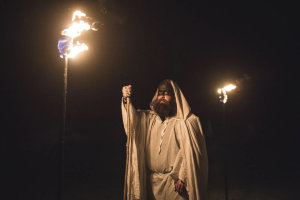
The concept of stories makes me reflect on the 4 years I spent practicing and studying Irish Paganism. Irish paganism is a reconstruction of Draíocht (Druidism) in pre-Christian Ireland. The very backbone of reconstructed paganism revolves around lore, mythological cycles and storytelling. In an Irish pagan storytelling circle, poets, such as the bard and filí oversee the story telling. The bard is a type of poet who focuses on satire, eulogies and stories of the day-to-day life of average people, sometimes in the form of a song. The filí is a poet who is considered to have the most elite role and tells stories that represent prophecy or divine knowledge (I.E., 2024). These are just two examples of storytelling roles, but the source of the stories always come from a place of Imbas Forosnaí meaning (Illuminated Inspiration) in old Irish (Kenna, 2021). In Irish paganism, storytelling provides support for most rituals, sabbats and rites. This is the power of story telling in action, because the stories are what energize the experience and connections between people and the event.

The circles of storytelling in Irish paganism include people from diverse backgrounds interacting with native Irish people. In Office Hours: The Power of Stories Part 2, Michael Stephens points out that, “Story-based experiences of all kinds can increase listeners’ understanding of diverse groups, demonstrate the value of everyone’s experience, and remind listeners of their shared humanity.” To encourage the best aspects of this shared humanity and understanding of diverse groups, the storytellers lead by example by keeping cultural competence in balance with cultural humility. The University of Oregon has created a toolkit, which is a helpful way to process the concept of this practice. Cultural competence involves having knowledge about a culture and cultural humility involves the ability to self-reflect and discern whether an adjustment in attitude or perspective in oneself is needed to understand another’s culture (Cultural Humility Toolkit, uoregon.edu). When these mindsets are balanced, cultural differences can have a positive impact rather than a negative one, inequalities can be addressed, and collaboration becomes more enjoyable. In a storytelling circle, this collaboration can bring about thought-provoking discussions, epiphanies and bonding.
References:
(IrishMyths.com), I. E. (2024, October 3). What’s the difference between a bard, a vate, and a Druid? Irish Myths. https://irishmyths.com/2022/05/27/bards-vs-vates-vs-druids/
Stephens, M. (2020, April 9). Office hours: The Power of Stories Part 2. INFO 287 – The Hyperlinked Library. https://287.hyperlib.sjsu.edu/office-hours-the-power-of-stories-part-2/
Kenna, S. (2021, February 17). Seer – fáidh, Filí, Fílidh, Fénnidi, Ollamh, poets. Bean Feasa. https://beanfeasa9.wordpress.com/fili/
Division of Equity and Inclusion menu. Cultural Humility Toolkit | Division of Equity and Inclusion. (n.d.). https://inclusion.uoregon.edu/cultural-humility-toolkit